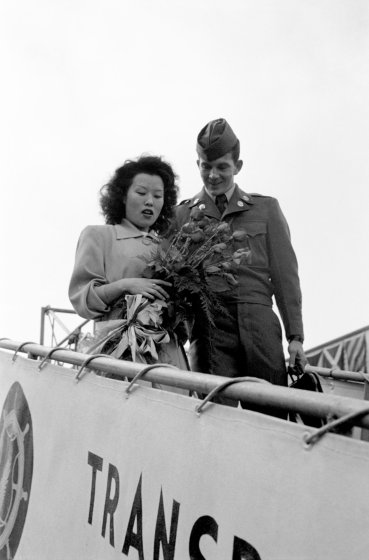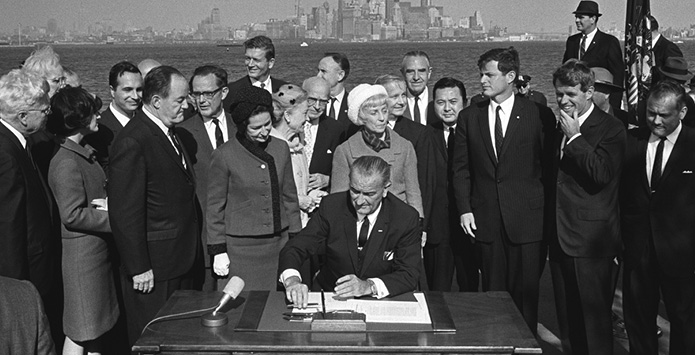History of Korean Immigration in New England, 1947 to Present
After the March 1st Movement, overwhelming majority of Korean immigrants in Boston consisted of elite educators and students. Many of these students were actively involved in the Korean Independence movement throughout New England, with the headquarters located in Boston University and Harvard University. After the liberation of Korea in 1945, there was a limited number of Korean immigrants to Boston. The majority of them consisted of government workers, educators, missionaries and pastors, and international students. Starting from 1947, inter-racial and international marriages started to increase due to America’s military presence in Korea. In 1947, the War Brides Act was established, which enabled Korean, Chinese, Filipino, and Japanese war brides to enter albeit with limited quota. Many military brides entered the U.S. during the mid-1950s. By 1965, 6,423 Korean War brides had immigrated to the U.S.[1]
In 1952, McCarran-Walter Act was instituted, revoking the 1924 Immigration Law that forbade Asians from entering America. This new act allowed Asian immigrants to obtain U.S. citizenship. From 1952 to 1964, there were around 15,000 Korean immigrants, of whom 6,423 were war brides, 5,348 war orphans who were adopted, and 3,278 international students.

After the Korean War ended with a ceasefire on 1953, there was a flux of Korean international students to the Greater Boston area. Some of the notable students included Kim Seongha (Boston University) who was in charge of Yenching Library Korean collection; Ko Kwang-lim (Harvard University); Jo Jeong Ja (Wellesley Colllege); Pak Daeseon (Boston University School of Theology), president of Yonsei University; Kim Yeongho (Boston University School of Dentistry), Yi Ku (Massachusetts Institute of Technology), Ko Tong-hye (Boston University), Kim Hwal-lan (Kim Helen, Boston University), and so forth.[2]
Postwar Korea was left in abject poverty, so Korean international students could not afford to pay tuitions on their own. The Korean government or missionaries funded the majority of these students, as many of them came from poor families. Yi Yeong-su, who studied Chemistry at Connecticut Women’s College reported that during the mid 1950s, the majority of the Korean international students in New England were male.

The Korean diaspora community in Boston started to grow with the increase of international students and visiting scholars who were sponsored by Yenching Institute. Harvard Yenching Institute started the exchange program in 1954, and began to invite thirty professors annually as exchange professors. Professors from Seoul National University, Korean University, Ewha Women’s University, Yonsei University, Seogang University, and others sent three to four of their finest scholars as visiting professors for one year.[3]
Between 1953 to 1967, 6,368 Korean international students came to the United States. The vasat majority (94%) in America, only 6% returned to Korea. The biggest reason for this was the political, economic, and intellectual insecurity of postwar Korea. Scholars who were educated in the greater Boston area perceived that there were more opportunities for them in America than in Korea, which was a developing country in the 1960s. New England, particularly Boston, saw a sharp increase of immigrants after the Immigration and Nationality Act of 1965, also known as the Hard-Celler Act.[4]

On October 3rd, 1965, President Lyndon Johnson signed the 1965 act into law in front of New York’s Statue of Liberty, affirming the democratic value upon which America was founded. This new act abolished the quota system based on race and ethnicity which had discriminated against non-northern Europeans and Asians. According to United States Citizenship and Immigration Services (USCIS), from July 1966 to September 1976, around 175,000 Korean immigrants entered the U.S. as permanent resident aliens.[5] The Korean population in New England continued to grow in the 1980s, becoming five times the size it was in the 1970s. The current Korean population in the United States is over 2,500,000, and in New England around 50,000.
Citations
[1] Grace M. Cho, Haunting the Korean Diaspora: Shame, Secrecy, and the Forgotten War (Minneapolis: Univ Of Minnesota Press, 2008).
[2] The New England Centennial Committee of Korean Immigration to the United States. History of Koreans in New England. Seoul, Korea: Seon-Hak Publishing, 2004.
[3] https://harvard-yenching.org/
[4] Gabriel J. Chin and Rose Cuison Villazor, eds., The Immigration and Nationality Act of 1965: Legislating a New America (New York, NY: Cambridge University Press, 2015).
[5] https://www.uscis.gov/